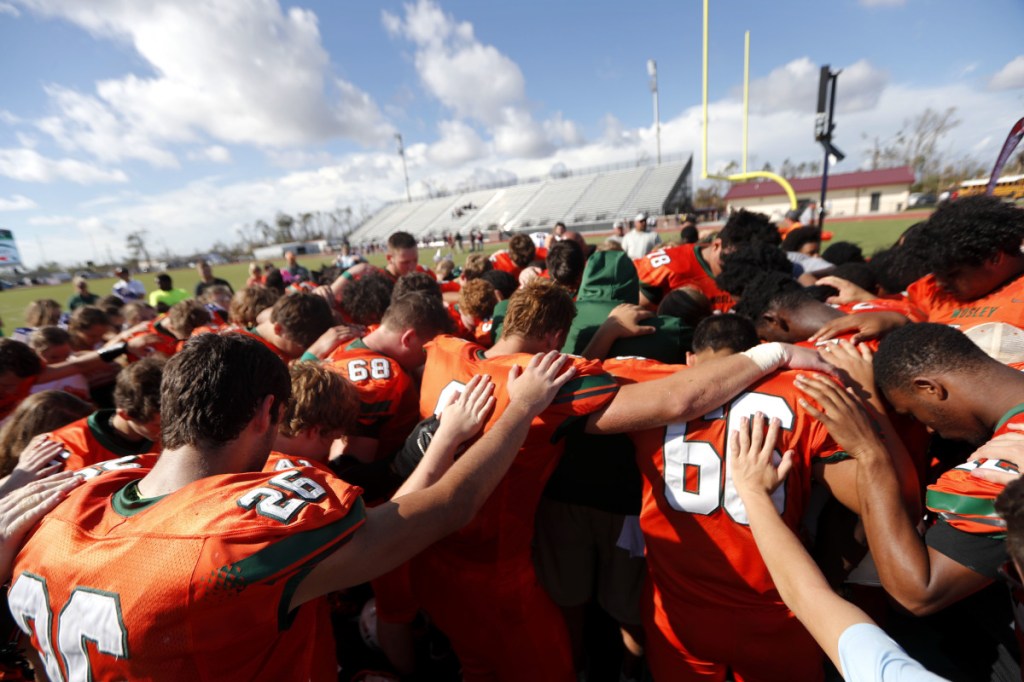PANAMA CITY, Fla. — When Noel Santiago came to save the kids from Hurricane Michael, they were frozen.
“They were in shock,” he said. “If you didn’t grab ’em by the arm and yank they wouldn’t’ve moved. Then who knows where they’d be.”
Santiago, 53, dragged his friend, 34-year-old Rosa Perez, and her two children, down to the first story of Macedonia Garden Apartments in Panama City as the howling winds of Hurricane Michael ripped the roof off their second-story apartment.
A week later, many of the residents of the public housing complex are still here. They’re camping out in the moldering remains of their shredded apartments and cars, cooking over fires in common areas and lighting their mildewing spaces with candles when night falls.
Like the tens of thousands displaced by the storm, many of these people don’t have places to go – or a way to get there if they did.
Residents huddle in hallways, smoking cigarettes and anxiously discussing their next moves. Perez has been making the rounds, telling other residents that management can’t make them leave.
“Legal services came and told us,” she said. “They can’t do that. They want FEMA to put us in a hotel and not take the rental voucher. Everybody is scared by that.”
Perez and her family lost everything in the storm. They’re living with a friend until Perez gets her FEMA voucher for two months’ rent. She doesn’t have a bank account, so she’s been waiting a week for the mail to be delivered with her voucher.
For many in the community, the world has narrowed to what’s within walking distance.
The nearest aid station its just over 2 miles away at a Baptist church. Without a vehicle or a shopping cart to carry the goods home in the scorching heat, it’s out of reach.
Perez got her first tarp Friday, when someone passing through handed out a few. The Red Cross brings hot meals daily, and occasionally FEMA or medical personnel come by. Residents keep a sharp eye for supply drops.
Hotels are booked up clear up to Mobile, Alabama, and the devastation and electricity problems are so widespread that rental homes are nearly impossible to find. Trailers and RVs are in short supply.
For some, the best, and most affordable, option is a shelter. A week after the storm, the population at the dozen shelters in this region of the Panhandle skyrocketed from 1,500 to nearly 2,400 in one day, with 500 more people in the three special-needs shelters.
Steven Wallace, 65, ended up in a shelter the day before the storm, when he realized he couldn’t survive a Category 4 hurricane in his Panama City apartment. He was right: His place was trashed, and his landlord sent him a notice that he had 72 hours to get out.
“I was told by others they plan to bulldoze it,” Wallace said.
He’s supposed to get his security deposit back, he said, but the voicemail box for the management company has been full since the storm so he hasn’t heard any news.
He slept on the floor with a blanket for three days at the Northside Elementary School shelter before cots were delivered. A couple of days later, he and the other shelter residents were moved to Surfside Middle School in Panama City Beach.
Send questions/comments to the editors.



Success. Please wait for the page to reload. If the page does not reload within 5 seconds, please refresh the page.
Enter your email and password to access comments.
Hi, to comment on stories you must . This profile is in addition to your subscription and website login.
Already have a commenting profile? .
Invalid username/password.
Please check your email to confirm and complete your registration.
Only subscribers are eligible to post comments. Please subscribe or login first for digital access. Here’s why.
Use the form below to reset your password. When you've submitted your account email, we will send an email with a reset code.